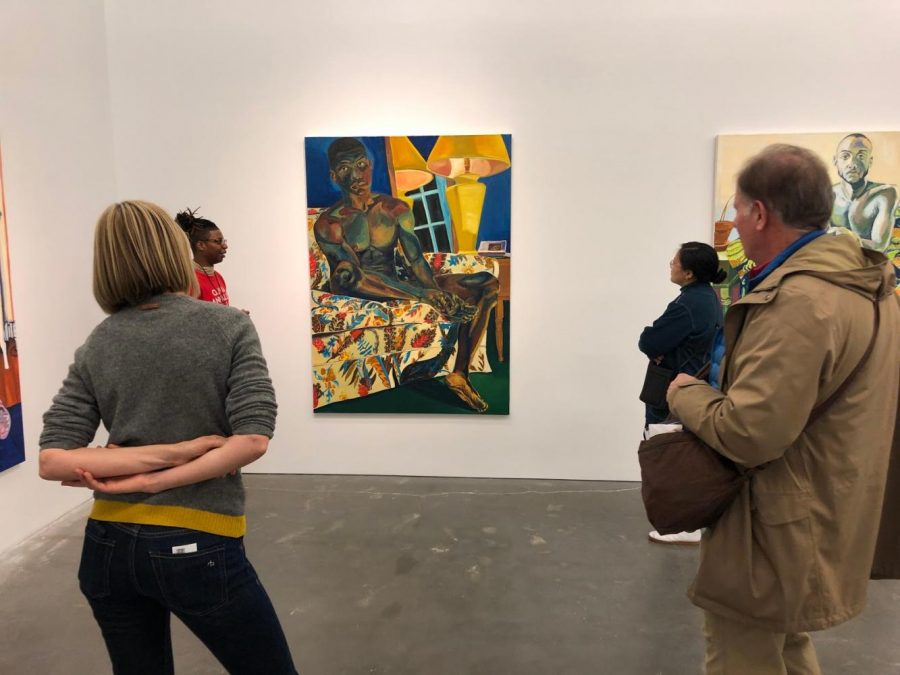A peculiar dichotomy is developing in the museums of the Greater New York City area: the uptown-neoclassical museum, with gargoyles slammed at the sides of some presentational doorway, now meets a more contemporary, downtown-white-walled museum with branding similar to an iPhone’s. Simple-fonted and blank-slated, the walls of the New Museum in the Lower East Side provide a canvas that has hosted countless seasonal exhibits, accessible on a web-page with the highlights of their exhibitions. As America’s diasporal communities come together to form identities divorced from colonial motherlands, a new American identity is being constructed through contemporary art. At the New Museum, we are witnessing exemplary works of these American people in the flesh.
One of these people is Jordan Casteel. She earned her Masters of Fine Arts at Yale University, educates students at Rutgers University’s Newark campus and lives in Harlem. Casteel’s specific way of putting oil paint on canvas was dubbed “a distinct figurative language.” Through it she’s able to reach out and touch the people of her multi-spatial communities in her exhibit, “Within Reach.”
From wherever her subjects reside, all of Casteel’s work is produced in a thematic manner one notices upon stepping into the exhibit. All of her subjects are in the foreground. While their backgrounds are abstracted, their facial and body features are well defined: a mixture of light and shadow is employed in a shapely manner to the angles of the faces of New York City youth, and you want to have a conversation with that realness.
By estimate, none of Casteel’s paintings are smaller than 3 feet by 4 feet wide, and in one of these paintings — Casteel’s 2014 painting, “Jonathan” — the artist uses the size of the canvas to hone in on details we would otherwise overlook. Rather than strictly adhering to artistic rules of studio study, “Jonathan” employs a set of visual cues that mock the Eurocentric foundations of what are considered the neoclassical artistic standard. It does so by using traditional studio study technique on a much larger canvas. Whereas the MET is keen to put small objects next to large objects in novelty display cases, all of the paintings exhibited in this insightful exhibit are the same size without distracting display narratives, collectively exclaiming, “We’re here!”
The methods Casteel uses to contradict colonial motifs also add an illustrative narrative about the lives of the people she paints. In “The Baayfalls,” a pair of two street vendors are placed so far to the fore of the painting that you feel as if you could walk into the painting and greet them yourself. So large and superimposed that it challenges the one-dimensional aesthetic of the older, stuffier, uptown museum. Another painting, “Lean,” of a child reaching for their guardian’s hand on the subway platform, tells a contrasting story. Here, the cool background of the steel subway door with its “do not lean on door” warning contrasts the beauty of a tender moment between parent and child with a bleak industrial quality. This same dichotomy between gentleness and colonialism harkens back to a post by @decolonizethisplace on Instagram, where the very same signage is spray-painted over in the movement’s solidarity against the MTA, which charges an immodest, inequitable $2.75 per subway ride. We are reminded of the way humanity is a prisoner to the capitalist machine that activists like Decolonize try to combat.
There is so much more than just this to be discovered in Casteel’s work. The works beckon each and every one of us to discover more meaning in their honest humanity. There’s only one thing left for you to do now: come see it for yourself.
A version of this article appears in the Monday, Feb. 24, 2020, print edition. Email Maxwell Freyre at [email protected].






















































































































































